Subtotal: £15.48
ALBINO GOLDEN CORYDORA NEON CORY CATFISH PEACEFUL TROPICAL HARDY FISH, Ideal Tropical Companions for Community Tanks, Easy to Care for, Perfect for Beginners!
£6.99 Original price was: £6.99.£5.81Current price is: £5.81.
Welcome the stunning Albino Golden Corydora, also known as the Neon Cory Catfish, into your aquarium. This peaceful tropical fish, with its vibrant golden hue, thrives in community tanks, making it a perfect choice for beginners seeking beautiful companions. Enjoy their graceful movements and gentle nature.
905 in stock
Species Introduction
The Albino Golden Corydora, scientifically classified within the Corydora genus, is a delightful freshwater fish that originates from the tranquil rivers and streams of South America. This species is characterized by its striking golden hue, which can vary in intensity, and its distinctive, almost translucent body. The Albino variant is particularly cherished among aquarists for its unique appearance, which adds a splash of color to any aquarium setup. As a member of the catfish family, these fish are known for their peaceful temperament and social behavior, making them ideal candidates for community tanks. Their natural habitat consists of soft, sandy substrates and plenty of hiding spots among aquatic plants, which mimic their wild environment and promote their well-being in captivity.
Care Requirements Dashboard
| Optimal Living Conditions | |
|---|---|
| Water Temperature | 22-28°C (72-82°F) |
| pH Level | 6.0-7.5 |
| Water Hardness | 2-15 dKH |
| Minimum Tank Size | 120L (30 gal) |
| Salinity | Freshwater |
| Care Level | Beginner to Intermediate |
✓ Care Level: Easy
Tank Size: Minimum 20 gallons
Water Temperature: 72°F – 78°F (22°C – 26°C)
pH Level: 6.0 – 7.5
Hardness: 2 – 12 dGH
Natural Behavior & Temperament
The Albino Golden Corydora is a peaceful and social fish that thrives in groups, ideally in schools of at least six individuals. This schooling behavior not only enhances their natural instincts but also promotes their overall health and happiness. In the aquarium, you will often observe them foraging along the substrate, using their sensitive barbels to search for food. Their playful nature makes them a joy to watch, as they dart around, interact with their tank mates, and explore their environment. They are generally non-aggressive and can coexist harmoniously with a variety of other community fish, making them a perfect addition to a diverse aquarium setup. Their calm demeanor and sociable behavior contribute to a tranquil atmosphere in your aquatic habitat.
Tank Setup Guide
Creating an optimal environment for your Albino Golden Corydora involves replicating their natural habitat as closely as possible. A minimum tank size of 20 gallons is recommended to provide ample swimming space and to accommodate a school of these fish. The substrate should be soft and sandy to protect their delicate barbels, while the addition of smooth rocks and driftwood can create hiding spots and territories. Live plants such as Java Fern and Anubias are excellent choices, as they provide cover and contribute to water quality through natural filtration. Ensure that there are open swimming areas and shaded regions to mimic their natural environment. Proper filtration is essential to maintain water quality, and a gentle water flow is preferred to avoid stressing these sensitive fish.
Water Quality Management
Maintaining optimal water quality is crucial for the health and longevity of your Albino Golden Corydora. The ideal water temperature should range between 72°F and 78°F (22°C – 26°C), with a pH level between 6.0 and 7.5. Regular water changes of 20-25% every two weeks are recommended to keep nitrate levels low and ensure a healthy environment. It’s important to monitor water hardness, aiming for a range of 2 to 12 dGH, as extreme fluctuations can stress these fish. Utilizing a quality aquarium test kit will help you keep track of these parameters. Additionally, the use of a reliable filtration system is essential, as it helps maintain clear water and removes harmful toxins. Regularly cleaning the filter media and ensuring proper water circulation will further enhance the living conditions for your aquatic companions.
Feeding & Nutrition
Feeding your Albino Golden Corydora a balanced diet is essential for their growth and overall health. These fish are omnivorous and thrive on a varied diet that includes high-quality sinking pellets, flakes, and frozen or live foods such as bloodworms and brine shrimp. A feeding schedule of 1-2 times per day is ideal, with only as much food as they can consume within a few minutes to prevent overfeeding and maintain water quality. It’s beneficial to provide a mix of foods to ensure they receive all necessary nutrients. Additionally, incorporating vegetable matter, such as blanched zucchini or spinach, can enhance their diet and promote healthy digestion. Monitoring their feeding behavior will also help you ensure they are receiving adequate nutrition and not being outcompeted by other fish.
Compatibility Guide
The Albino Golden Corydora is an excellent choice for community tanks due to its peaceful nature and compatibility with a wide range of fish species. Ideal tank mates include small to medium-sized fish such as tetras, rasboras, and guppies, which share similar water parameter requirements. However, it is crucial to avoid larger, aggressive species that may intimidate or harm these gentle fish. When selecting tank mates, consider the behavior and temperament of each species to ensure a harmonious environment. Additionally, having a well-planted tank with plenty of hiding spots will help reduce stress and provide security for all inhabitants. Regularly observing interactions among fish will help you identify any compatibility issues early on.
Tank Mate Compatibility Guide
Great Tank Mates
- Small Tetras
- Rasboras
- Guppies
Avoid These Tank Mates
- Larger Cichlids
- Aggressive Species
Compatibility Note: Always research specific species requirements and observe fish behavior when introducing new tank mates. Individual fish personalities can vary!
Health & Wellness
Maintaining the health of your Albino Golden Corydora involves regular monitoring for signs of illness and stress. Common health issues include ich, fin rot, and bacterial infections, which can often be prevented through proper care and water quality management. Signs of illness may include lethargy, loss of appetite, or changes in behavior. Regular water testing and maintaining stable parameters are essential for disease prevention. If you notice any signs of distress, it is crucial to isolate the affected fish and seek appropriate treatment. Additionally, ensuring that your fish friends are not overcrowded and that their tank mates are compatible will contribute to their overall well-being. Regular health checks and a proactive approach to care will help ensure a long and healthy life for your aquatic companions.
Breeding Information
Breeding Albino Golden Corydoras can be a rewarding experience for aquarists. To encourage spawning, it is best to maintain a separate breeding tank with optimal conditions, including slightly cooler water temperatures and plenty of hiding spots. When ready to breed, females will become noticeably rounder as they fill with eggs. Males will chase the females, and once spawning occurs, the female will lay eggs on flat surfaces, such as leaves or glass. After spawning, it’s advisable to remove the adults to prevent them from eating the eggs. The eggs typically hatch within 3-5 days, and the fry will require infusoria or finely crushed flakes until they are large enough to consume regular food. Providing a separate rearing tank for the fry will help ensure their survival and growth.
Acclimation Process
When introducing your Albino Golden Corydora to a new aquarium, it is essential to acclimate them properly to minimize stress and ensure a smooth transition. Begin by floating the sealed bag containing the fish in the tank for about 15-20 minutes to equalize the temperature. After this, gradually introduce small amounts of tank water into the bag over the course of another 15-30 minutes. This process helps the fish adjust to the water parameters of their new environment. Once acclimated, gently release the fish into the tank using a net to avoid adding any transport water that may contain harmful substances. Monitoring their behavior closely during the first few days will allow you to ensure they are adjusting well and settling into their new home.
Long-term Care
The Albino Golden Corydora is known for its long lifespan, often living 5-10 years with proper care. To ensure a long and healthy life, it is crucial to provide consistent care, including maintaining water quality, a balanced diet, and a suitable environment. Regular water testing and changes will help prevent the buildup of harmful toxins, while a varied diet will support their nutritional needs. Additionally, monitoring their behavior and health will allow you to address any issues promptly. Over time, you may notice changes in their behavior or appearance, which can indicate their age or health status. Keeping a close eye on your fish friends will help you enjoy their company for many years to come.
Natural Habitat Recreation
Creating a biotope that reflects the natural habitat of the Albino Golden Corydora can enhance their well-being and promote natural behaviors. In the wild, these fish inhabit slow-moving waters with sandy bottoms, dense vegetation, and plenty of hiding spots. To recreate this environment, consider using a soft substrate, such as fine sand, and adding a variety of plants to provide cover and spawning sites. Incorporating driftwood and rocks will also create natural barriers and territories. The use of floating plants can provide shade and reduce light intensity, mimicking their natural habitat. Additionally, maintaining a gentle water flow will help replicate the conditions they thrive in, ensuring that your aquatic companions feel at home.
Seasonal Care Adjustments
As seasons change, it is important to adjust the care routine for your Albino Golden Corydora to accommodate fluctuations in temperature and water conditions. During warmer months, ensure that the tank is well-ventilated and consider using a fan or chiller to maintain stable temperatures. In contrast, during colder months, it may be necessary to use a heater to keep the water within the ideal range. Additionally, monitor water parameters more frequently during these transitions, as changes in temperature can affect pH and hardness levels. Regularly check for signs of stress or illness, as these can become more pronounced during seasonal shifts. Adapting your care routine to seasonal changes will help ensure the continued health and happiness of your aquatic friends.
Expert Tips
For those looking to provide the best care for their Albino Golden Corydora, consider implementing some expert tips. First, ensure that your tank is adequately cycled before introducing any fish, as this will create a stable environment. Regularly monitor water parameters and invest in a quality water testing kit. Additionally, consider establishing a routine for feeding and maintenance to minimize stress for your fish. Providing a varied diet will not only enhance their health but also encourage natural foraging behaviors. Lastly, consider joining online forums or local aquarist groups to share experiences and gain insights from fellow fish keepers. These resources can provide valuable information and support as you care for your aquatic companions.
Troubleshooting
If you encounter issues with your Albino Golden Corydora, it is essential to address them promptly to ensure their well-being. Common problems include stress from aggressive tank mates, poor water quality, and inadequate diet. If you notice signs of stress, such as hiding or lethargy, consider re-evaluating tank mates and ensuring that water parameters are within the ideal range. If your fish are not eating, check for signs of illness and adjust their diet accordingly. Additionally, if you observe any physical abnormalities, such as frayed fins or discoloration, it may indicate a health issue requiring immediate attention. Keeping a close eye on your fish friends and being proactive in addressing potential problems will help maintain a healthy aquarium environment.
Scientific Background
The Albino Golden Corydora is part of the extensive Corydora genus, which encompasses numerous species of freshwater catfish. These fish are known for their unique adaptations, such as their specialized barbels that aid in foraging along the substrate. Research has shown that Corydoras exhibit a range of behaviors that contribute to their survival in the wild, including schooling and nesting. Conservation efforts are essential to protect their natural habitats from pollution and habitat destruction. By understanding the scientific background of these fish, aquarists can better appreciate their needs and contribute to their conservation in the wild.
Advanced Care Techniques
For experienced aquarists, implementing advanced care techniques can enhance the quality of life for your Albino Golden Corydora. Consider utilizing a planted tank with a diverse ecosystem to promote natural behaviors and improve water quality. Additionally, experimenting with different feeding techniques, such as target feeding or using feeding rings, can encourage foraging and stimulate their natural instincts. Regularly participating in water quality testing and adjusting parameters as needed will help maintain a stable environment. Lastly, consider documenting your fish’s growth and behaviors, as this can provide valuable insights into their health and well-being over time. By adopting these advanced techniques, you can ensure that your aquatic companions thrive in their environment.
Water Quality Parameters
Optimal Range
24-27°C
6.5-7.5
0 ppm
Caution Zone
22-24°C or 27-29°C
6.0-6.5 or 7.5-8.0
0.25-0.5 ppm
Danger Zone
<22°C or >29°C
<6.0 or >8.0
>0.5 ppm
Monitoring Tip: Test water parameters weekly and perform regular water changes to maintain optimal conditions for your aquatic friends!
Frequently Asked Questions
Q: What tank size is required for Albino Golden Corydoras?
Albino Golden Corydoras thrive in a tank that is at least 60 litres. This provides ample space for swimming and foraging, as they are bottom-dwelling fish. A larger tank allows for better water quality and stability, which is crucial for their health. Ensure the tank is well-planted with hiding spots, as Corydoras appreciate a secure environment. In a larger tank, you can also keep a small group of them, as they are social creatures and thrive in schools of 5 or more. This not only enhances their well-being but also brings out their natural behaviour, making for a more engaging aquarium experience.
✓ Expert Tip
Consider using a sand substrate as it is gentle on their delicate barbels.
Q: What water parameters do Albino Golden Corydoras require?
Albino Golden Corydoras prefer slightly acidic to neutral water, ideally between a pH of 6.5 to 7.5. The temperature should be maintained between 22°C to 26°C. Regular water changes of 20-30% weekly help to keep the water clean and free of toxins. Ammonia and nitrite levels should be at 0 ppm, while nitrate levels should be kept below 20 ppm for optimal health. Using a good quality water conditioner can help to neutralise harmful chemicals. It’s essential to regularly test water parameters and adjust them as needed to ensure a stable environment, which is crucial for the well-being of these fish.
✓ Expert Tip
Invest in a reliable water testing kit to monitor your aquarium’s parameters effectively.
Q: How often should I feed Albino Golden Corydoras?
Feeding Albino Golden Corydoras should be done 2-3 times a day with small amounts they can consume within a few minutes. A varied diet is essential for their health, including high-quality sinking pellets, frozen or freeze-dried foods such as bloodworms or brine shrimp, and vegetable matter like blanched peas or zucchini. Ensure that the food is suitable for bottom feeders, as they forage along the substrate. Overfeeding can lead to poor water quality, so it’s crucial to monitor the quantity and remove any uneaten food. A well-rounded diet will promote vibrant colours and overall well-being.
✓ Expert Tip
Consider rotating their diet to include different food types for balanced nutrition.
Q: What are the best tank mates for Albino Golden Corydoras?
Corydoras species, including Albino Golden Corydoras, are known for their peaceful nature, making them suitable for community tanks. Ideal tank mates include small, non-aggressive fish such as tetras, rasboras, guppies, and other peaceful bottom dwellers like dwarf shrimp. It is essential to avoid larger or aggressive species that may harass them. Keeping them in groups of five or more encourages natural behaviours and reduces stress. Ensure that all tank mates have similar water parameter requirements to maintain a harmonious environment for all inhabitants.
✓ Expert Tip
Observe interactions during the initial introduction to ensure compatibility.
Q: How do I properly acclimatise Albino Golden Corydoras to my aquarium?
Acclimatising Albino Golden Corydoras is crucial to help them adjust to their new environment. Begin by floating the sealed bag in your aquarium for about 15-20 minutes to equalise the temperature. After this, gradually introduce water from your aquarium into the bag—about a cup every 10 minutes. This process should take approximately an hour. Once the acclimatisation is complete, gently place the fish into the tank using a net to avoid introducing bag water, which may contain harmful substances. This method reduces stress and promotes a smoother transition.
✓ Expert Tip
Ensure your aquarium is well-prepared with stable parameters before introducing new fish.
Q: What are the signs of healthy Albino Golden Corydoras?
Healthy Albino Golden Corydoras exhibit active swimming behaviour, with bright colours and clear eyes. They should display a natural curiosity, foraging along the substrate and interacting with tank mates. Their fins should be intact and not frayed, and their body should be free of lesions or signs of stress, such as clamped fins. Regular feeding habits and a healthy appetite are also indicators of good health. Monitoring their behaviour regularly can help detect any issues early, allowing for prompt intervention if necessary.
✓ Expert Tip
Keep an eye out for any changes in behaviour, as they can indicate health issues.
Q: How do I successfully breed Albino Golden Corydoras?
Breeding Albino Golden Corydoras can be a rewarding experience. To encourage breeding, provide a separate breeding tank with a soft substrate and plenty of hiding spots. Ensure the water temperature is slightly elevated (around 26-28°C) and maintain excellent water quality. Introduce a breeding group of males and females, as they will engage in a courtship display. After spawning, which involves the female laying eggs on flat surfaces, remove the adults to prevent them from eating the eggs. The eggs will hatch in 3-5 days, and the fry can be fed infusoria or finely crushed flakes until they are large enough for more substantial food.
✓ Expert Tip
Monitor the fry closely and perform regular water changes to maintain optimal conditions.
Q: What temperature should I maintain for Albino Golden Corydoras?
Albino Golden Corydoras thrive in a temperature range of 22°C to 26°C. Maintaining a stable temperature within this range is vital for their health and well-being. Sudden fluctuations can lead to stress and health issues. Use a reliable aquarium heater to regulate the temperature, and consider a thermometer to monitor it accurately. During warmer months, ensure that the tank does not exceed 26°C, as higher temperatures can negatively affect their metabolism and overall health.
✓ Expert Tip
Use a fan or cooler if necessary to prevent overheating in summer months.
Q: How long do Albino Golden Corydoras typically live in captivity?
With proper care, Albino Golden Corydoras can live between 5 to 10 years in captivity. Factors such as water quality, diet, and tank conditions significantly influence their lifespan. Regular maintenance, including water changes and tank cleaning, alongside a balanced diet, will help ensure a long and healthy life. Keeping them in a stable environment with compatible tank mates will also contribute to their overall happiness and longevity.
✓ Expert Tip
Track their health and behaviour to catch any potential issues early.
Q: What type of substrate is most suitable for Albino Golden Corydoras?
For Albino Golden Corydoras, a soft substrate such as sand or fine gravel is ideal. This type of substrate is gentle on their sensitive barbels, which they use for sensing their environment. Sand allows them to forage naturally, as they will sift through it looking for food. Avoid sharp or coarse substrates, as they can cause injury. Additionally, adding smooth stones or driftwood can enhance their habitat, providing hiding spots and a more natural environment.
✓ Expert Tip
Consider creating a varied landscape with different substrate types to mimic their natural habitat.
Q: What behavioural patterns should I expect from Albino Golden Corydoras?
Albino Golden Corydoras are social and active fish, often seen foraging in groups at the bottom of the tank. They exhibit playful behaviour, darting around and exploring their environment. When kept in schools, they display a natural hierarchy, often engaging in gentle interactions. They are peaceful by nature and tend to avoid confrontation, making them excellent community fish. Observing their behaviours can provide insight into their health and happiness; any significant changes may indicate stress or illness.
✓ Expert Tip
Provide plenty of hiding spots and plants to encourage natural behaviours.
Q: How can I prevent common diseases in Albino Golden Corydoras?
Preventing diseases in Albino Golden Corydoras involves maintaining excellent water quality and a stable environment. Regular water changes and monitoring parameters can significantly reduce stress and disease prevalence. Quarantining new fish before introduction to the main tank is also essential to prevent the spread of pathogens. Additionally, providing a varied diet with high-quality foods supports their immune system. Keeping an eye on their behaviour and health can help catch any signs of illness early, allowing for prompt treatment.
✓ Expert Tip
Consider adding natural treatments or medications to the tank as a preventative measure.
Q: What lighting conditions do Albino Golden Corydoras prefer?
Albino Golden Corydoras thrive in moderate lighting conditions. Bright lights can stress them out, so it’s advisable to use dimmable LED lights or provide shaded areas within the tank using plants and decorations. Ideally, aim for a photoperiod of around 10-12 hours a day to mimic their natural environment. This will promote healthy plant growth and also provide a comfortable habitat for the fish. Regularly adjusting light intensity can help cater to their comfort and well-being.
✓ Expert Tip
Utilise floating plants to diffuse light and create a more natural environment.
Q: How do I recognise stress in Albino Golden Corydoras?
Signs of stress in Albino Golden Corydoras can manifest as erratic swimming, hiding excessively, or displaying clamped fins. If they are not feeding or exhibiting unusual behaviours, it may indicate that they are uncomfortable in their environment. Other signs include colour fading or heavy breathing. It’s essential to assess water quality, tank mates, and overall conditions if any of these signs are observed. Prompt action can often alleviate stress and restore their well-being.
✓ Expert Tip
Create a calm environment by minimising sudden movements near the tank.
Q: What natural habitat conditions should I replicate for Albino Golden Corydoras?
To replicate the natural habitat of Albino Golden Corydoras, focus on creating a soft-bottomed substrate with plenty of hiding spots, such as driftwood and plants. They thrive in slow-moving waters with ample vegetation, so incorporating live plants and decorations can enhance their environment. Maintain slightly acidic to neutral pH levels and ensure stable temperatures. Mimicking their natural conditions will help promote their health and behaviour, allowing them to flourish in your aquarium.
✓ Expert Tip
Consider using natural materials to enhance the aesthetic and health of their environment.

 Purple Vampire Crab - Geosesarma Dennerle - Decapod Crustacean
Purple Vampire Crab - Geosesarma Dennerle - Decapod Crustacean 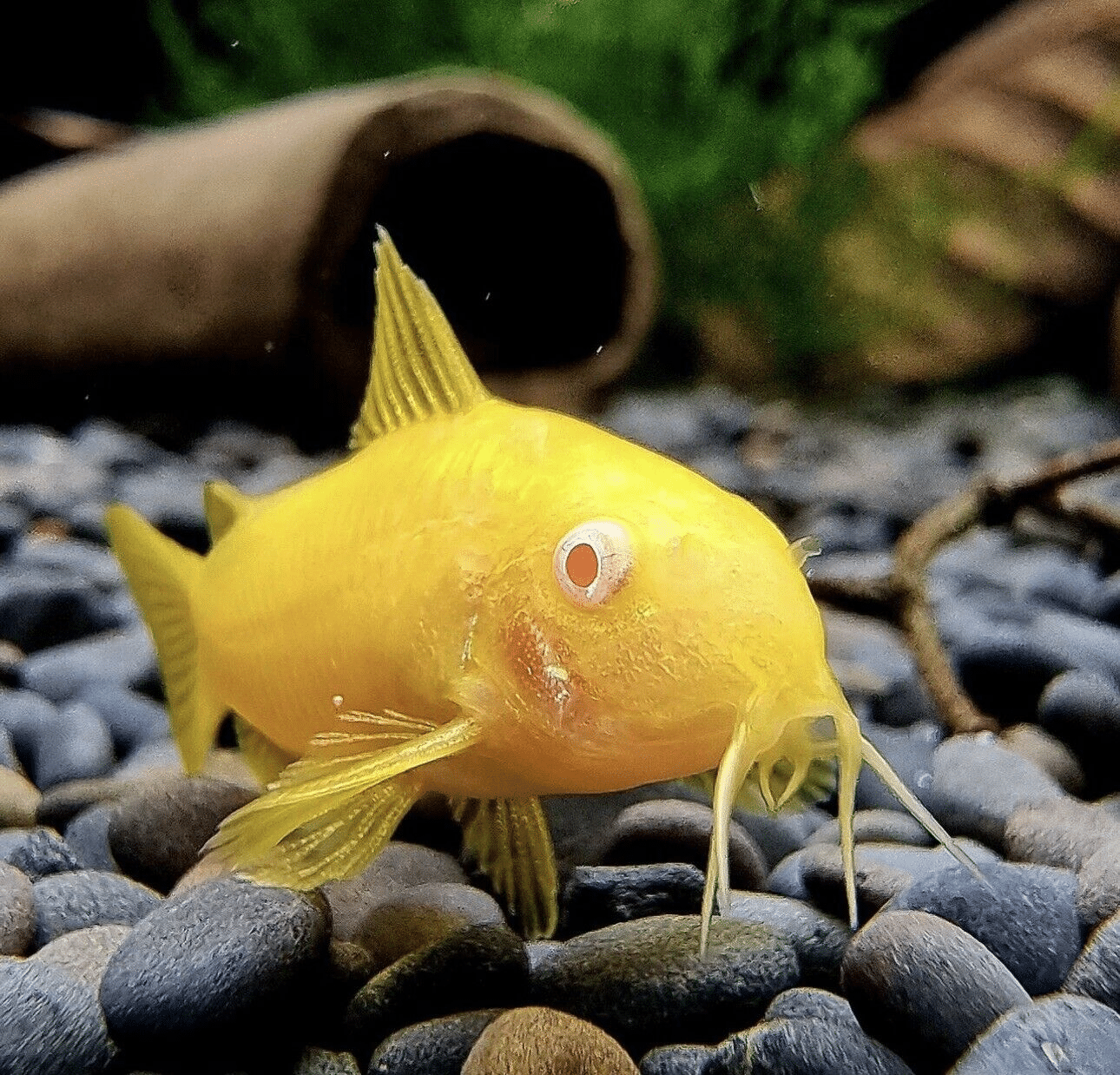
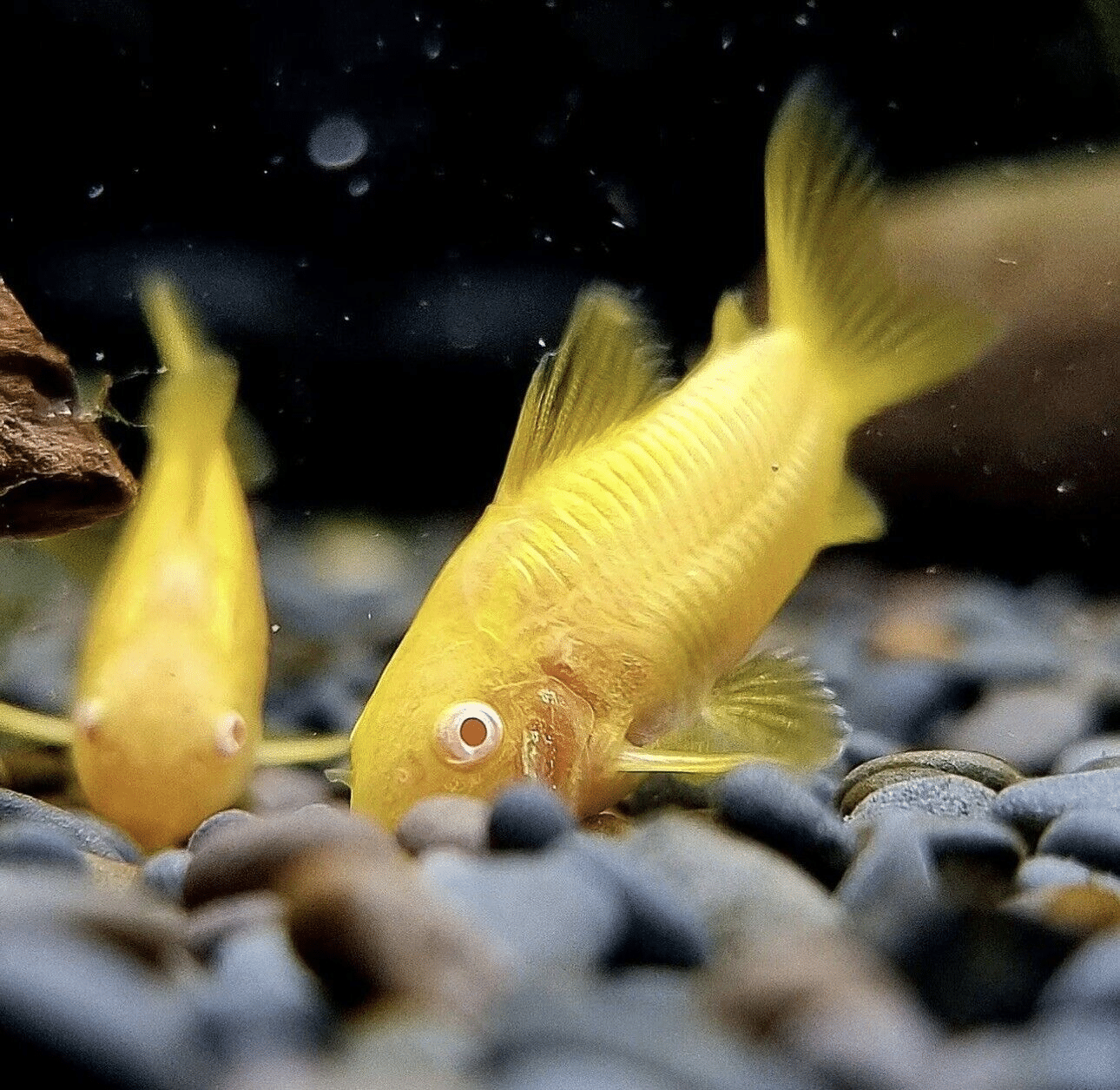
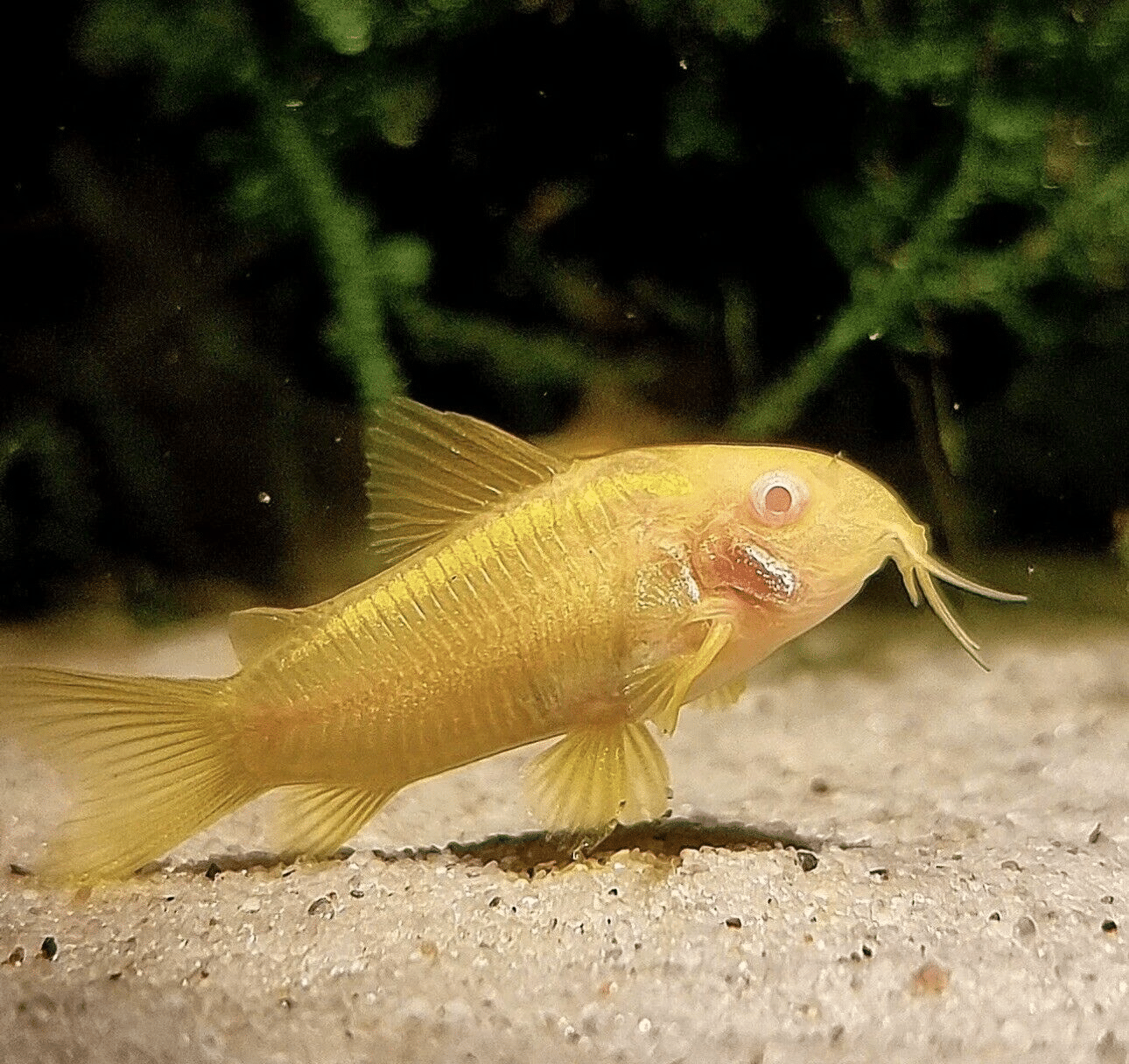
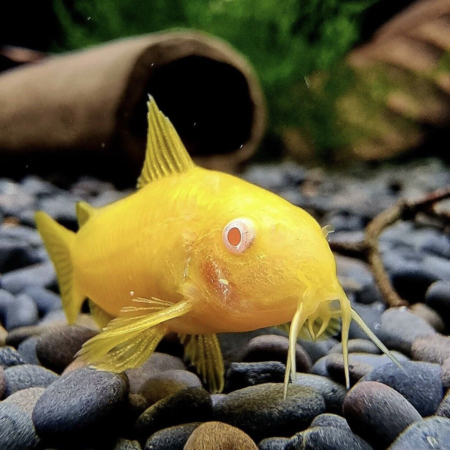

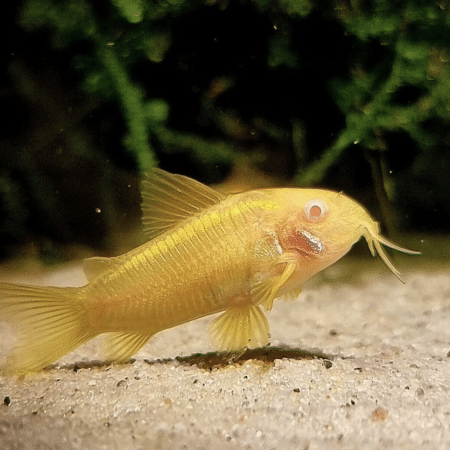

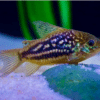










Emily Carter (verified owner) –
I recently added the Albino Golden Corydora Neon Cory Catfish to my 55-gallon community tank, and I couldn’t be happier! These little guys are not only stunning with their bright colors but are also incredibly peaceful and hardy, making them ideal for beginner fish enthusiasts like myself. After about two months of watching them thrive, I can confidently say they are a joy to have. They love to scavenge around the substrate, helping to keep my tank clean, which is a big plus! Compared to other corydora catfish I’ve kept, these albino goldens are more active during the day, which is delightful to see. I did notice a slight hesitation when introducing them to my existing fish, but they quickly acclimated within a week. My only minor concern is that they do enjoy a bit of hiding space, so I recommend adding some plants or decorations to accommodate their natural behavior. If you’re considering adding tropical fish to your aquarium, these are a fantastic choice. They truly enhance the community tank experience!